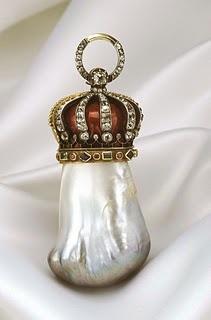The Pearl: an Organic Beauty
Known since Antiquity and still conquering the hearts of women today...

The word Pearl comes from the Latin "perna" which means shell and the word mother-of-pearl which comes from the Persian "nakkar" which means "beautiful and shimmering".
There are 2 types of pearls: fine pearls that are extremely rare and cultured pearls, whose formation is caused by man.
What's a fine pearl?
Fine pearls form naturally in oysters or mussels without human intervention unlike cultured pearls. Their formation begins when a parasite enters the oyster/mussel and the mollusc defends itself. It will send a pearl sac on the parasite and surround it. This bag will then begin to produce layers of mother-of-pearl and after several years, or even several decades, a pearl will form. The mollusk will constantly want to eject the impurity, and will make the pearl shift until ejection.

Fine pearl in its oyster

Honthrost, Young Woman with Pearls, 1644/ credit: La Tour Camoufle

Hortense de Beauharnais portrait, Queen of Holland by François-Pascal-Simon Gérard, circa 1806
We tend to think that there are only pearls with a pearly appearance, but that's not the truth!
There are also pearls with a porcelain aspect which are known for their sparkles, giving them an exceptional look. These pearls are all the more extraordinary, because cultured pearls can't be that way. These are the pearls of Conch -which are pink- and the orange pearls of Melo Melo.
Historically, the most beautiful fine pearls in the world come from the Persian Gulf, and more particularly from the island of Bahrain. These pearls are known for their incredible luster due to the presence of freshwater as well as saltwater currents.
The oldest pearl known to date is the "Pearl of Umm Al Quwain". It's 7,500 years old and was discovered in what is now the United Arab Emirates.
Before the invention of pearl farming, pearls were harvested in the Persian Gulf, Sri Lanka, China and some rivers in Europe.

Conch pearl from the Strombus Gigas shell
What is a cultured pearl?
Cultured pearls follow the same principle of formation as fine pearls, however it's not an impurity that will cause the pearl but a nucleus introduced by man: this is the grafting process. The core is made of Mississippi mussel shell cut into logs. These beads are covered with epithelial cells (mollusk cells) so that the graft takes. This is deposited in the gonad and then the shell is put back in a body of water for several years.
There are 4 types of cultured pearls:
- Akoya pearls found mainly in Japan. In their natural state they are pinkish white, yellow, cream or green. They can be treated so that they are whiter, silver or champagne. In 1893 Kokichi Mikimoto perfected the method of farming pearls in Japan and thus came Akoya pearls. Mikimoto was the first to find a pearl farming method that produced such beautiful pearls. It is still widely used today.

Mikimoto Akoya pearl and diamond necklace
- Tahitian pearls are known for their black, aubergine, gray or even emerald green hues. Their farming is quite recent since it began in the 1920s. However, it's only with the help of Japanese specialists that this activity really developed.
- South Sea pearls or Australian pearls are obtained by the same process as Japanese pearls. These pearls usually have golden hues and are rather chunky. They can also be treated to obtain another shade.

South Sea Pearls / Australian Pearls
- Freshwater pearls or Chinese pearls have been cultivated since the 13th century in Chinese rivers. They look like Akoya pearls and natural pearls which can be confusing. For a very long time, freshwater pearls were small pearls, but in recent years there have been bigger and whiter freshwater pearls.
Classification of pearls
- Color
The color varies depending on the shell and graft, the oyster's food, the temperature and the amount of salt in the water.
- Size
Size is measured in millimeters. Only fine pearls are weighed in grain: one grain = 0.25 carats = 0.05 grams.
- Form
There are many shapes of pearl, in reality fine pearls are very rarely round because the impurity that causes it can be of different shapes. We then obtain pears shapes as well as ovals, drops or even baroque pearls.
- Aspect
The aspect is defined by:
- the pearl's thickness
- its surface quality
- its luster (reflection of the light from the surface)
- its orient (ability of the light to penetrate the nacre layer)
Pearl Substitutes:
- Beads by M. Jacquin, produced since the 17th century. These are glass beads coated with a mixture of pearl essence (bleak scales with ammonia water).
- Majorca pearls, made of plastic dipped in a pearl essence and varnished on the surface.
Finally, here are some well-known fine pearls:
The Hope Pearl: A fine pearl weighing 1800 grains, it is one of the largest natural baroque pearls in the world.

The Hope pearl
The "centaur" pearl is a fine baroque pearl surrounded by a decoration made of gold, rubies, diamonds and enamel. This work of art was presented at the Natural History Museum during the "Pearls" exhibition.
The 68 pearls of Baroda: These pearls were in the same necklace formed of 7 rows of fine pearls. They are owned by the Maharajahs of Baroda.

If you are interested in pearls, do not hesitate to discover what Julie's stones offer you in store...
We are also available for any free expertise of your vintage jewelry, for this you can send an email with your photos to contact@lespierresdejulie.com.
Whether you're interested in buying a piece of jewellery or a stone, a free jewelry appraisal or jewelry resale, Pierres de Julie welcomes you to its Parisian boutique in the Village Suisse, a stone's throw from the Ecole Militaire and the Esplanade des Invalides.
Nouveautés
- 900 €
- 900 €
- Unit price
- / per
- 3.900 €
- 3.900 €
- Unit price
- / per
- 9.500 €
- 9.500 €
- Unit price
- / per
- 2.900 €
- 2.900 €
- Unit price
- / per










